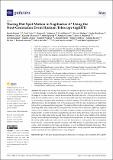Tracing Hot Spot Motion in Sagittarius A* Using the Next-Generation Event Horizon Telescope (ngEHT)
Author(s)
Emami, Razieh; Tiede, Paul; Doeleman, Sheperd S.; Roelofs, Freek; Wielgus, Maciek; Blackburn, Lindy; Liska, Matthew; Chatterjee, Koushik; Ripperda, Bart; Fuentes, Antonio; Broderick, Avery E.; Hernquist, Lars; Alcock, Charles; Narayan, Ramesh; Smith, Randall; Tremblay, Grant; Ricarte, Angelo; Sun, He; Anantua, Richard; Kovalev, Yuri Y.; ... Show more Show less
Downloadgalaxies-11-00023.pdf (7.318Mb)
Publisher with Creative Commons License
Publisher with Creative Commons License
Creative Commons Attribution
Terms of use
Metadata
Show full item recordAbstract
We propose the tracing of the motion of a shearing hot spot near the Sgr A* source through a dynamical image reconstruction algorithm, StarWarps. Such a hot spot may form as the exhaust of magnetic reconnection in a current sheet near the black hole horizon. A hot spot that is ejected from the current sheet into an orbit in the accretion disk may shear and diffuse due to instabilities at its boundary during its orbit, resulting in a distinct signature. We subdivide the motion into two different phases: the first phase refers to the appearance of the hot spot modeled as a bright blob, followed by a subsequent shearing phase. We employ different observational array configurations, including EHT (2017, 2022) and the next-generation Event Horizon Telescope (ngEHTp1, ngEHT) arrays, with several new sites added, and make dynamical image reconstructions for each of them. Subsequently, we infer the hot spot angular image location in the first phase, followed by the axes ratio and the ellipse area in the second phase. We focus on the direct observability of the orbiting hot spot in the sub-mm wavelength. Our analysis demonstrates that for this particular simulation, the newly added dishes are better able to trace the first phase as well as part of the second phase before the flux is reduced substantially, compared to the EHT arrays. The algorithm used in this work can be easily extended to other types of dynamics, as well as different shearing timescales. More simulations are required to prove whether the current set of newly proposed sites are sufficient to resolve any motions near variable sources, such as Sgr A*.
Date issued
2023-01-29Department
Massachusetts Institute of Technology. Department of Physics; MIT Kavli Institute for Astrophysics and Space ResearchPublisher
Multidisciplinary Digital Publishing Institute
Citation
Galaxies 11 (1): 23 (2023)
Version: Final published version